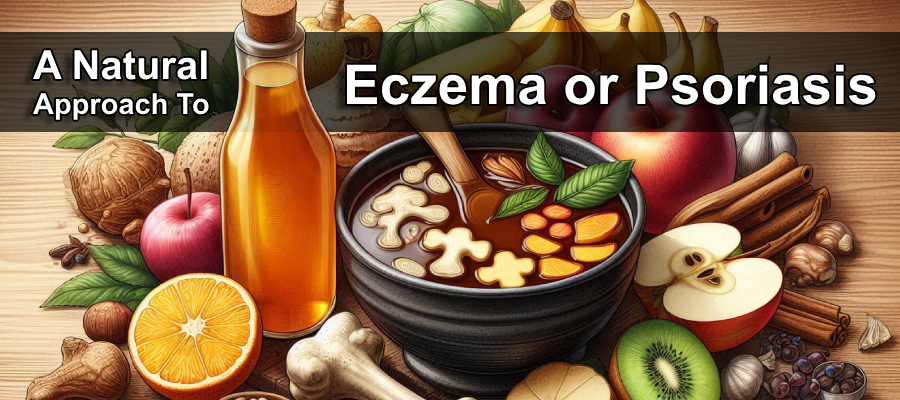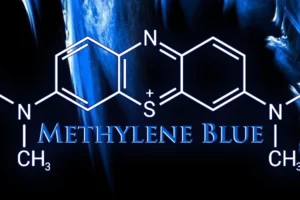A Natural Approach to Eczema or Psoriasis
Are you or someone you know suffering from eczema or psoriasis but also struggling to find answers? Are things just not ‘adding up?’ Is it possible that our underlying assumptions about such conditions have been flawed? If so, then there is a good chance that we are simply not asking the right questions.
From an allopathic medicine standpoint, inflammatory skin conditions such as eczema, psoriasis, and other forms of dermatitis are typically considered idiopathic autoimmune diseases (Verma et al., 2020). In other words, many physicians are under the assumption that these conditions just ‘sort of happen,’ although most typically recognize that genetic predispositions or environmental triggers likely exist. That’s our opportunity! Nonetheless, the typical answer is to shut down the immune system. However, that might be a rather dramatic step. This is especially true, considering the body is trying to tell us something. So, the question is, “Do these conditions just sort of happen?” Accordingly, is the answer to shut down the immune system?
Emerging evidence seems to suggest that perhaps such notions are not entirely accurate. In recent years, several studies seem to suggest that these conditions may be caused by pathogens, particularly bacteria. The role of chemokines and cytokines in the development of inflammatory skin diseases such as atopic dermatitis, psoriasis, and skin mastocytosis is quite telling. After all, these molecules play a crucial role in the body’s immune response and defense… against pathogens (Nedoszytko et al., 2014). If we are dealing with a pathogen, is shutting down the immune system appropriate? Shouldn’t this new understanding challenge some of our underlying assumptions regarding these conditions, as well as form new questions regarding their treatment?
NOTE: Before we proceed, it’s important to note that the information provided in this article is not intended as a universal solution. Furthermore, it is being simplified for the sake of wider understanding. Indeed, inflammatory skin conditions like eczema and psoriasis are complex, come in several forms, and are influenced by various factors that may differ from person to person. Every angle cannot be addressed in a simple article. So, while this article offers insights and potential treatments, remember that individual responses can vary significantly. Understanding and addressing these conditions requires a personalized approach, considering factors such as severity, underlying causes, and any concurrent health issues.
The Potential Bacterial Connection
As stated, several studies have suggested that eczema or psoriasis may be less of an autoimmune disease and more of a disease caused by differences in bacterial composition on the skin. In fact, we now understand that there are some strong links between microbial communities and skin-related inflammatory diseases (Baviera et al., 2014). For example, abnormal bacterial skin colonization is a common characteristic of atopic eczema, with Staphylococcus aureus (S. aureus) being the most common pathogen (Ring, Abeck, & Neuber, 1992). Other studies suggest that the overall microbiome plays a significant role in the development and management of atopic eczema, while changes in the diversity of the microbiota and the presence of bacterial pathogens likely play a role in triggering the inflammation associated with the condition (Marrs & Flohr, 2016; Thomas & Fernández‐Peñas, 2017).
We are finding similar bacterial connections with psoriasis. For example, some research suggests that psoriasis is initiated by an abnormal response to bacteria in the skin due to genetic factors (Fry et al., 2015). Other research demonstrates that Psoriasis and Crohn’s disease (CD) are strongly linked, with CD patients being five times more likely to develop psoriasis and vice versa. Of course, CD is often seen as resulting from a loss of immune tolerance to intestinal microbiota in genetically susceptible individuals (Fry et al., 2013). In fact, another study even found the presence of live bacteria in the blood of patients with psoriasis (Munz et al., 2010). And the list goes on.
This perspective might also help to explain the rheumatoid arthritis (inflammation of joints) that typically comes with such conditions. Perhaps this arthritis is nothing more than reactive arthritis and chronic infectious arthritis. Of course, a definitive answer to this will likely remain elusive as the bacteria responsible for these conditions are often difficult to cultivate from synovial samples. However, it is still something important to ponder. Ultimately, we must remember that the absence of evidence is not evidence of absence.
Regardless, when examining other forms of dermatitis, we find a similar connection. For example, one study identified a link between bacterial superantigens and the immune response in dermatitis patients, suggesting that removing lipophilic coryneform bacteria from the skin can help manage the condition (Breuer, Kapp, & Werfel, 2001). Another study implicates the presence of MRSA as a contributing factor to the severity of dermatitis (Shi et al., 2018). Again, the list goes on.
A common theme seems to be emerging. Bacteria! However, if bacteria are the common factor or theme, and if we continue to see these connections the more we look, then at some point, we should probably listen to reason. And with that in mind, we should also probably rethink the idea that eczema or psoriasis are not contagious. After all, if the bacteria associated with such conditions can be spread, then so too might the opportunity to develop such conditions. And frankly, this bacterial connection might also help to explain the numerous anecdotal accounts of individuals with no history of such condition suddenly acquiring eczema or psoriasis after long-term proximity to those who already have it, such as after marriage.
Now, while a definitive answer remains elusive, at the very least, we do know that bacterial pathogens and alterations in the microbiota likely play a significant role in triggering the inflammation associated with these conditions. While correlation doesn’t necessarily equate to causation, this information does open the door to a whole new line of research and a whole bunch of exciting questions to answer. Of course, this insight also provides you and me with a unique opportunity to address such issues at home.
Potential Home Remedies to Explore
If skin microbiota plays a role in developing eczema or psoriasis, then there is actually quite a bit that we do to improve outcomes. For our purposes here, insights can be found in studies that propose the potential use of bacteria transplants as a therapy (Abbasi, 2018). These findings suggest that restoring healthy bacterial communities might help people outgrow or manage such conditions. The question is, “How can we do that?” The answer is much simpler than you might think.
Given the potential bacterial cause, home remedies targeting pathogens and restoring microbial balance could be effective. However, for this approach to work, we need to understand three things. First, there is the topical approach to calm inflammation, address the potential infection, and heal the skin. Second, there are the internal factors that support the skin. And third, there is the restoration of the skin’s microbiome for the long term.
#1 – Topical Treatments for Infection and Inflammation
There are plenty of options for an active infection and to calm inflammation. Be sure to check with your healthcare provider for advice. However, one such remedy is Bald’s Eye Salve, an ancient antimicrobial ointment that is known to help reduce inflammation and address any underlying infection. This remedy would be a great place to start. Simply start by using Bald’s Eye Salve until you see improvement or resolution. This will help address any infection and calm inflammation, which is a big part of the equation.
In addition, several other at-home options can effectively reduce inflammation and address infections associated with eczema and psoriasis. Aloe vera gel, known for its soothing and healing properties, can be applied directly to affected areas to calm irritated skin and promote healing. Its natural anti-inflammatory compounds help alleviate itching and redness. Calendula ointment is another beneficial remedy due to its anti-inflammatory and antimicrobial properties, which can aid in healing and preventing infections.
For those preferring essential oils, tea tree oil diluted in a carrier oil like coconut or jojoba oil can provide antiseptic benefits, reducing bacteria on the skin and easing inflammation. Additionally, colloidal oatmeal baths or compresses can help relieve itching and inflammation, providing a gentle, protective barrier for sensitive skin. Of course, as with any treatment, it’s advisable to consult with a healthcare provider to ensure these options are suitable for your specific condition and to discuss potential interactions with other treatments or medications you may be using.
#2 – Internal Factors
One thing to know is that there could be other underlying factors contributing to these conditions. Antibiotic-related or diet-related intestinal imbalances, nutritional deficiencies, and environmental or other behavior-related elements might also play a role. Furthermore, if an individual is absent an appendix, that could be another potential factor worth consideration. Either way, just remember that exploring these causes can be complex and may take time, but understanding that health is a matter of cause and effect is vital.
That said, know that addressing your diet opens the door to addressing intestinal dysbiosis. Try to address any deficiencies. Also, focus on consuming whole, nutrient-dense foods such as lean proteins, healthy fats, and low-sugar but high-fiber fruits (such as berries). Avoid foods high in antinutrients like certain grains, legumes, real vegetables, and processed foods. Incorporating fermented foods, such as kefir, will promote a healthy gut microbiome. This dietary approach can help restore balance to your intestinal flora and improve overall digestive health while helping to starve the bad bacteria in both our intestines and skin.
Finally, one might consider anti-inflammatories. Numerous options exist, but Palmitoylethanolamide (PEA) might be a great option for some. PEA is a naturally occurring fatty acid amide that has shown promise in reducing inflammation and pain, particularly in chronic conditions. It works by supporting the body’s natural anti-inflammatory response without causing significant side effects. Research suggests that PEA can help manage symptoms associated with various inflammatory conditions, including skin disorders like eczema and psoriasis. As always, consulting with a healthcare provider is recommended to determine the suitability of PEA or any other anti-inflammatory treatment based on individual health needs and conditions.
Learn About the ‘Omnivore Diet’ – CLICK HERE
Learn About Microbial Diversity on an ‘Omnivore Diet’ – CLICK HERE
Drop Down: Supplemental and Dietary ‘Medicine’
I have a protocol for ambiguous infections that you might also find valuable. My starter pack always includes plenty of bone broth and healthy fats like coconut and avocado to prime the body. Then, I take therapeutic doses of Olive Leaf Extract and Berberine HCL. Olive Leaf Extract, rich in oleuropein, has broad-spectrum antimicrobial activity and immune-boosting properties, disrupting bacterial cell walls. Berberine HCL inhibits bacterial DNA synthesis and damages cell membranes, showing strong antibacterial effects against pathogens, including staphylococcus species. Used together, they can have a synergistic effect but should be administered under professional guidance. Additionally, incorporating Manuka Honey for its methylglyoxal and garlic for its allicin can further enhance the antimicrobial action.
#3 – The Skin’s Microbiome
For long-term management, restoring the microbial balance on the skin (and in the gut) is crucial. For this, we turn to kefir. Kefir is a fermented milk drink originating from the Caucasus region, traditionally made by inoculating cow, goat, or sheep milk with kefir grains. These grains are a symbiotic culture of bacteria and yeasts (SCOBY) that ferment the milk, resulting in a tangy, slightly effervescent beverage rich in probiotics. Kefir is known for its potential health benefits, including enhancing gut health, boosting the immune system, and possibly improving digestion. It is thicker than regular milk but thinner than yogurt, making it versatile for drinking on its own or incorporating into smoothies and other recipes. The fermentation process also breaks down lactose, making kefir more tolerable for those with lactose intolerance.
And yes, drinking kefir is great, and I often recommend that people do. However, I’m suggesting that applying ‘real’ kefir to the skin – in addition to its consumption – can help restore the balance we seek. Research indicates that people with eczema or psoriasis often have less microbial diversity in their colon and on their skin, likely due to repeated antibiotic use or a poor diet. However, restoring this balance through probiotics like kefir can be a potential treatment. This truth is evidenced by the studies that have shown that topical and oral use of fermented dairy products helps to improve skin health (Vaughn & Sivamani, 2015).
Probiotics are the key. Probiotics, such as Lactobacilli and Bifidobacterium, are known to mediate skin inflammation, treat atopic dermatitis (AD), and prevent allergic contact dermatitis (ACD). Kefir specifically is filled with these bacteria. Moreover, probiotics can also decolonize skin pathogens like P. aeruginosa, S. aureus, and A. vulgaris while supporting skin immunity by treating pathogens through their antimicrobial substances and natural prebiotics (Lolou & Panayiotidis, 2019). Ultimately, by restoring a healthy balance of beneficial bacteria, kefir (probiotics) can enhance the skin’s barrier function, reduce inflammation, and promote overall skin health, making kefir a valuable component in managing and preventing various skin conditions.
Using Kefir for the Skin (and Gut)
The practical application of kefir is fairly straightforward. Simply rub plain kefir on the skin and leave it on for at least 20 to 30 minutes before lightly rubbing or washing it off. Then, repeat this process 3 to 4 times a day. Also, remember that city water typically has either chlorine or fluoride, which are antimicrobial. Hence, reapplication of kefir, especially after showers, is essential to maintain its beneficial effects.
Home-brewed kefir is usually best because it is stronger and has more beneficial microbes. Best of all, you can make your own for the price of a gallon of milk and a few dollars for kefir grains, which are reused for each batch. It’s easy to make, delicious as a berry smoothie, and great for the skin (and gut). So, you just use some on the skin and then drink the rest. If you would like to acquire some kefir grains, I will always, and without hesitation, recommend Kefir Lady.
A Potential Alternative to Kefir
If kefir is not your style, there is another option to consider. Home-brewed kombucha might be a decent alternative. Kombucha is a fermented tea rich in probiotics, which, when consumed, can help balance the gut microbiome and support overall digestive health. When applied topically (using the kefir protocol), the beneficial bacteria and yeast in kombucha, such as Lactobacillus and Saccharomyces, can contribute to skin health by mediating inflammation and combating harmful pathogens. Additionally, kombucha contains antioxidants and organic acids that, either topically or internally, may further enhance its therapeutic effects on the skin, making it a versatile option for those seeking natural remedies for such skin conditions.
Keeping an Open Mind
Indeed, these ideas and remedies show promise and are supported by several studies. However, we must also remember that the exact causes of many inflammatory skin conditions are still not fully understood, and further research is needed to confirm the role of pathogens and the effectiveness of such treatments. That said, there is plenty of anecdotal evidence to suggest these options do help to some degree. Perhaps they will work for you as well.
It’s also important to keep an open mind about potential solutions. Whether we are talking about eczema or psoriasis, physicians and patients alike should remain open to exploring new and seemingly unconventional treatments, especially considering the evolving understanding of the microbiome’s role in skin health. Undoubtedly, as our knowledge grows, so too might our ability to effectively treat and manage these conditions with such simple solutions.
And finally, we should also understand that this article is meant to address bacterial connections. Indeed, fungal, viral, allergy, chemical, and contact connections exist in some cases as well. This means that the options and perspectives presented in this article likely will not apply in every case. Similarly, and as awesome as all of this might sound, it’s also crucial to consult with your trusted healthcare professionals before trying new treatments to ensure they are appropriate and safe for you.
This article is dedicated to ‘Sarah.’ Let’s all send good vibes her way.
Dr. Robertson is a health researcher and educator, not a physician. The information provided here is not medical advice, a professional diagnosis, opinion, treatment, or service to you or any other individual. The information provided is for educational and anecdotal purposes only and is not a substitute for medical or professional care. You should not use the information in place of a visit, call consultation, or the advice of your physician or other healthcare providers. Dr. Robertson is not liable or responsible for any advice, course of treatment, diagnosis, or additional information, services, or product you obtain or utilize. IF YOU BELIEVE YOU HAVE A MEDICAL EMERGENCY, YOU SHOULD IMMEDIATELY CALL 911 OR YOUR PHYSICIAN.
References
Abbasi, J. (2018). Are bacteria transplants the future of eczema therapy? JAMA, 320(11), 1094–1095. https://doi.org/10.1001/jama.2018.12334
Alves, E., Gregório, J., Baby, A. R., Rijo, P., Rodrigues, L. M., & Rosado, C. (2021). Homemade Kefir Consumption Improves Skin Condition-A Study Conducted in Healthy and Atopic Volunteers. Foods (Basel, Switzerland), 10(11), 2794. https://doi.org/10.3390/foods10112794
Baviera, G., Leoni, M. C., Capra, L., Cipriani, F., Longo, G., Maiello, N., … & Galli, E. (2014). Microbiota in healthy skin and in atopic eczema. BioMed research international, 2014(1), 436921.
Breuer, K., Kapp, A., & Werfel, T. (2001). Bacterial infections and atopic dermatitis. Allergy, 56(11), 1034-1041.
Fry, L., Baker, B. S., Powles, A. V., Fahlen, A., & Engstrand, L. (2013). Is chronic plaque psoriasis triggered by microbiota in the skin?. British Journal of Dermatology, 169(1), 47-52.
Fry, L., Baker, B. S., Powles, A. V., & Engstrand, L. (2015). Psoriasis is not an autoimmune disease?. Experimental dermatology, 24(4), 241-244.
Habeebuddin, M., Karnati, R. K., Shiroorkar, P. N., Nagaraja, S., Asdaq, S. M. B., Khalid Anwer, M., & Fattepur, S. (2022). Topical Probiotics: More Than a Skin Deep. Pharmaceutics, 14(3), 557. https://doi.org/10.3390/pharmaceutics14030557
Lolou, V., & Panayiotidis, M. I. (2019). Functional role of probiotics and prebiotics on skin health and disease. Fermentation, 5(2), 41. https://doi.org/10.3390/fermentation5020041
Marrs, T., & Flohr, C. (2016). The role of skin and gut microbiota in the development of atopic eczema. British Journal of Dermatology, 175(S2), 13-18.
Munz, O. H., Sela, S., Baker, B. S., Griffiths, C. E., Powles, A. V., & Fry, L. (2010). Evidence for the presence of bacteria in the blood of psoriasis patients. Archives of dermatological research, 302, 495-498.
Nedoszytko, B., Sokołowska-Wojdyło, M., Ruckemann-Dziurdzińska, K., Roszkiewicz, J., & Nowicki, R. (2014). Chemokines and cytokines network in the pathogenesis of the inflammatory skin diseases: atopic dermatitis, psoriasis and skin mastocytosis. Advances in Dermatology and Allergology/Postępy Dermatologii i Alergologii, 31(2), 84-91.
Ring, J., Abeck, D., & Neuber, K. (1992). Atopic eczema: role of microorganisms on the skin surface. Allergy, 47(4), 265-269.
Shi, B., Leung, D. Y., Taylor, P. A., & Li, H. (2018). MRSA colonization is associated with decreased skin commensal bacteria in atopic dermatitis. The Journal of investigative dermatology, 138(7), 1668.
Thomas, C. L., & Fernández‐Peñas, P. (2017). The microbiome and atopic eczema: More than skin deep. Australasian Journal of Dermatology, 58(1), 18-24.
Vaughn, A. R., & Sivamani, R. K. (2015). Effects of fermented dairy products on skin: A systematic review. The Journal of Alternative and Complementary Medicine, 21(7), 380–385. https://doi.org/10.1089/acm.2014.0261
Verma, N. K., van Steensel, M. A. M., Prasannan, P., Poh, Z. S., Irvine, A. D., & Oon, H. H. (2020). Common skin diseases: Chronic inflammatory and autoimmune disorders. Imaging Technologies and Transdermal Delivery in Skin Disorders.




